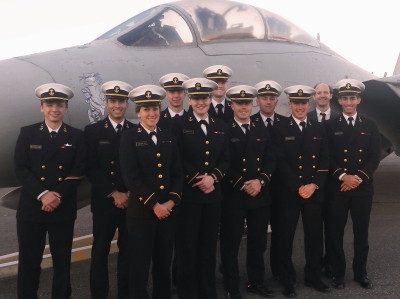Posted on
 U.S. Naval Academy midshipmen and their electrical engineering professor are pictured during their Naval Surface Warfare Center Dahlgren Division (NSWCDD) tour Dec. 4. (U.S. Navy photo by Bruce Naley/Released)
U.S. Naval Academy midshipmen and their electrical engineering professor are pictured during their Naval Surface Warfare Center Dahlgren Division (NSWCDD) tour Dec. 4. (U.S. Navy photo by Bruce Naley/Released)
DAHLGREN, Va. (Dec. 17, 2015)—U.S. Naval Academy (USNA) midshipmen learned first-hand during a visit here that what happens in Dahlgren, does not stay at Dahlgren.
What is happening through research, development, testing and evaluation has left—or will be leaving—the labs and test ranges to support warfighters and the Fleet.
Moreover, the Midshipmen, bound for the Fleet upon graduation from the Naval Academy as newly commissioned officers, are destined to work with technologies developed at Naval Surface Warfare Center Dahlgren Division (NSWCDD) and other NSWC divisions.
"Our recent trip to NSWC Dahlgren depicted a vast array of projects currently being explored and their applicability to our fundamental studies as electrical engineers and the enthusiasm of Dahlgren's investigators," said USNA midshipman Chris Panuski, a double-major in electrical engineering and physics. "At each of the various sites that we visited, the engineers and technicians enthusiastically shared their work with us at a level well suited to our undergraduate background."
NSWCDD civilian scientists and engineers answered questions about their work on current and emerging technologies that the academy students will see throughout their careers aboard warships.
Electromagnetic railgun—one of many highlights for the midshipmen—is being developed for use on a wide range of ships. The railgun launcher is a long-range weapon that fires projectiles using electricity instead of chemical propellants. Magnetic fields created by high electrical currents accelerate a sliding metal conductor, or armature, between two rails to launch projectiles at 4,500 mph to 5,600 miles per hour.
Counter-improvised explosive device (IED) directed energy technology; radio frequency anechoic chamber and antenna characterization techniques; and future naval radar technology test-bed prototypes were also featured in the midshipmen's tour and briefings.
The USNA Electrical and Computer Engineering Program provides students with the fundamental tools to sense, measure, communicate, interface, and process energy (power, light, or wireless) and information (data, signal processing, and embedded systems). The program provides a thorough technical background that applies to all branches of naval service as well as civilian life.
"It has always been my firm belief that the greatest depth of learning happens when students observe and understand how the theories and concepts taught in the classroom are applied to real-world engineering problems," said Dr. Chris Anderson, a USNA associate professor of electrical engineering who accompanied the midshipmen. "Electrical and computer engineering is a profession with an extraordinary amount of breadth. NSWC Dahlgren showcased numerous aspects of electrical and computer engineering from the engineering perspective, including systems that these midshipmen would be interacting with as future Navy and Marine Corps officers."
In addition, Navy civilian engineers at the Potomac River Test Range briefed the future officers at the range where naval guns have been tested since 1918. The students saw how Dahlgren continues to provide the military with the technical capability and leadership to solve complex warfighting needs.
After their tour, some of Panuski's midshipmen colleagues also shared their perspectives about what happens at Dahlgren:
• The USNA Institute of Electrical and Electronics Engineers Chapter's trip to Dahlgren offered me an indispensable look at the research and development that is advancing the capabilities of our armed forces today.
• It was a great experience because I was able to see the next generation of weapons that will be affecting me in the fleet. These are the weapons and technology that will affect the future battle space and how the Navy conducts operations.
• At the Naval Academy we tend to focus our studies on the traditional educational aspects of electrical engineering, but we also have the opportunity to learn about its applications to our future as naval officers. Traveling to Dahlgren gave us the chance to combine the best of both worlds. From the high powered railgun—a concept we reproduced on a small scale in class—to futuristic IED detection and elimination: we saw what impacts an electrical engineer can have. I hope that someday I will have the awesome opportunity to study and use technology like we saw in our recent trip to Dahlgren.
• The Dahlgren trip let me see how the things we get to explore as electrical engineering undergrads scale up in the world of research and development. For example, the small anechoic chamber we have in one of our classrooms at the academy was completely dwarfed by the one at Dahlgren, but the technology behind it and the things it's used for are fundamentally the same.
• The experience was beneficial because it gave us a clearer view of the world of professional electrical engineering, whereas at school our view is often limited to the academic side of the field.
• The trip to Dahlgren was awesome. It gave us a chance to see the theories behind electricity and magnetism applied practically. The scale of their projects was amazing and the engineers working at
• Dahlgren gave us all a view of a potential future career. Seeing the railgun up close was very interesting—it's an opportunity that few people ever get, and I consider myself very lucky. The antenna chamber, radar equipment, and 18-inch guns were very interesting to learn about as well.
NSWCDD, a NAVSEA warfare center division, is a premier research and development center that serves as a specialty site for weapon system integration. The command's unique ability to rapidly introduce new technology into complex warfighting systems is based on its longstanding competencies in science and technology, research and development, and test and evaluation.

